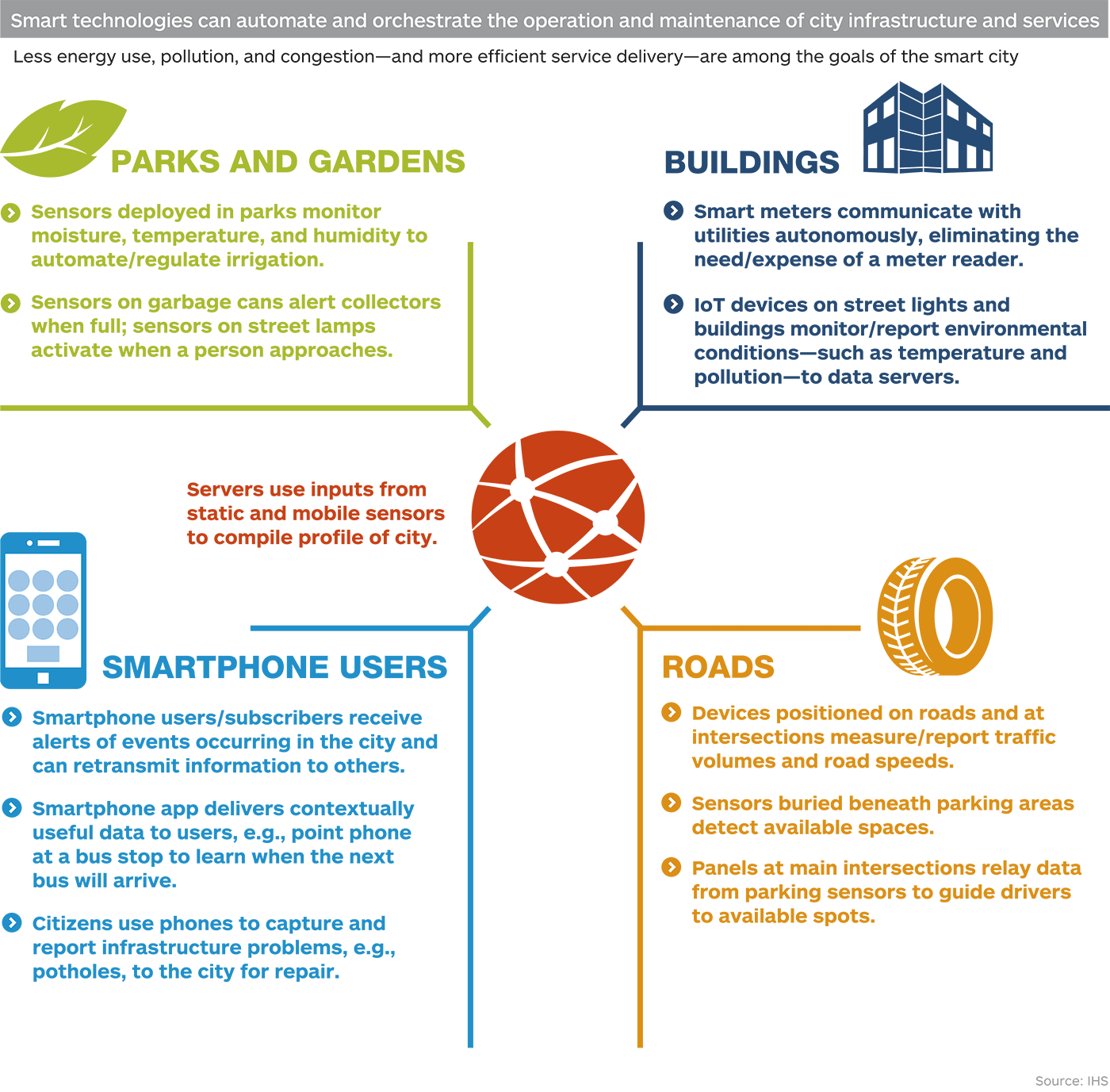“Smart cities” used to refer to high levels of brainpower, but not any more. The term has been coopted by the Internet of Things (IoT) and now presents designers with a golden opportunity to innovate.
Though the definition of “smart city” may vary, the drivers are consistent: rapid urbanization combined with low-cost computing and communication have together created the conditions for rapid and furious innovation around applying the Internet of Things (IoT) to help cities run better.
In our previous report, “Smart Agriculture: How IoT Can Help Feed 9.1 Billion People” we discussed the global migration from rural to urban and suburban regions, whether it be for work, security, family or all of the above. This of course has put enormous pressure on city governance to streamline processes and make them more cost effective to accommodate the population influx.
Low-hanging fruit ripe for optimization includes energy, trash disposal, water and sewage treatment, and first responder safety, as well as streetlights and parking availability monitoring. Add in pollution control and security concerns, and it becomes clear that monitoring and gathering data to “connect the dots” and make cities smarter overall is a good thing.
But what exactly is a smart city? Research firm IHS did a pretty good job of defining a smart city in its July 2014 report, “Smart Cities: Business Models, Technologies and Existing Projects.” In the report, Lisa Arrowsmith, associate director for connectivity, smart homes and smart cities at IHS narrowed the term to describe smart cities as those, “…that have deployed—or are currently piloting—the integration of information, communications and technology (ICT) solutions across three or more different functional areas of a city.”
Arrowsmith’s functional areas cut across many of those mentioned, defining them as, “…mobile and transport, energy and sustainability, physical infrastructure, governance, and safety and security.”
In theory, the amount of alcohol consumed in an establishment or locale can be tracked and checked against the number of accidents at a nearby junction to see if there’s any correlation. In practice, police in cities such as Los Angeles are using systems such as PredPol to predict criminal activity in order to make policing more efficient and effective.
Last year, Intel decided to help Dublin, Ireland, become the most sensored city in the world using its Quark-based IoT gateways, with up to six sensors per gateway. The initial application included pollution monitoring, with cyclists being encouraged to “sensorize” in order to detect the most polluted areas and find better routes. The subtext is that cities such as Dublin want to become smarter to attract more investment.

IHS Research has its own definition of a smart city, but however you define it, it’s the application of technology to every aspect of city management that presents a golden – and global – opportunity for designers.
LA and Dublin aren’t alone. Based on its definition, IHS expects there will be at least 88 smart cities all over the world by 2025, up from 21 in 2013, with Asia-Pacific taking over the lead in 2025 from the combined Europe-Middle East-Africa (EMEA) region, which represented the largest number of smart cities in 2013.
Making this transition to smart cities is a golden opportunity for system designers and sensor manufacturers. While much of the attention goes to the likes of Cisco, Oracle and IBM who are driving the data discussion, MEMS sensor manufacturers, such as Bosch, STMicroelectronics, and Analog Devices, stand in the path of a windfall as sensors become pervasive.
At the same time, system designers like you stand to benefit from cracking the code to efficient, low-power sensing systems that can withstand outdoor environmental extremes for long periods of time. And there are plenty of companies springing up to help you.
In between the sensors and the IoT cloud are the GPS/GNSS module makers such as u-blox that simplify device tracking, while subsystems such as Intel’s gateways can help provide an almost complete solution so you can focus on the product application, differentiation and software. To get you connected to the cloud and commission devices, resources available to you include Echelon, ThingWorx, Sensys Networks, and Synapse.
Smart cities are coming, fast. It’s exciting, fun and totally up to you to determine what role you’d like to play to make it happen.
By Patrick Mannion
Advertisement
Learn more about Electronic Products Magazine





